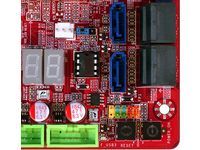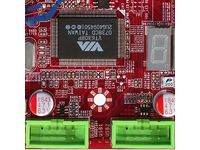Does 790FX + SB750 = High-End Overclocking?
Foxconn A79A-S

Foxconn took a more calculated approach to launching its high-end Spider platform motherboard, waiting for the SB750 to arrive before releasing any 790FX product. That means the A79A-S is an all-new product, and that Foxconn had a very long time to prepare and test its new board, since the earlier southbridge is pin-compatible.
PCI Express 2.0 slots look somewhat more crowded than on the competing Asus product, but looks can be deceiving—both products block off one, and only one, graphics card slot when double-thick graphics coolers are used. Both motherboards are limited to a maximum of three double-slot cards, such as the high-end HD 4870 or four single-slot cards, such as the mid-market HD 4850.

Foxconn’s use of a five-phase voltage regulator might be seen as a potential weakness in light of Asus’ 10-phase design, but our overclocking results are a better indicator of the effect on stability.
Some Windows XP users will be happy to see the rarely used A79A-S floppy connector in a more advantageous location, since these ease installation of the venerable OS on RAID arrays, but the similarly outdated Ultra ATA connector is still found below the motherboard’s center line.

We have mixed feelings about the Serial ATA port orientation. Four forward-facing ports allow long graphics cards to be used without interference, but they may themselves be blocked off by lower-bay hard drive cages on some tower-style cases. The other two ports face outward, allowing installation in tight cases but with the potential to be blocked off by long graphics cards. At least Foxconn has considered both circumstances, and we doubt many users will put long cards into tight cases.
Like its competition, the A79A-S has power and reset buttons near the front of its bottom edge, which are perfect for bench testing. But Foxconn goes one step further by adding a two-digit POST code reader to aid in diagnosing failed overclock attempts (as well as other boot failures). Also notice the removable BIOS IC, a feature that makes bad-flash recovery as easy as plugging in a replacement.
Onboard Devices
| Northbridge | AMD 790FX |
| Southbridge | AMD SB750 |
| Voltage Regulator | Five Phases |
| BIOS | 080015 (08/21/2008) |
| 200.0 MHz (HT 2000) | 200.0 MHz (+0.00%) |
| Clock Generator | ICS 9LPRS918JKLF |
| Connectors and Interfaces | Row 6 - Cell 1 |
| Onboard | 4x PCIe 2.0 x16 (Modes: Two x16 or Four x8) |
| Row 8 - Cell 0 | 1x PCIe x1 |
| Row 9 - Cell 0 | 1x PCI |
| Row 10 - Cell 0 | 3x USB 2.0 (2 ports per connector) |
| Row 11 - Cell 0 | 1x IEEE-1394 FireWire |
| Row 12 - Cell 0 | 1x Floppy |
| Row 13 - Cell 0 | 1x Ultra ATA (2 drives) |
| Row 14 - Cell 0 | 6x Serial ATA 3.0Gb/s |
| Row 15 - Cell 0 | 1x Front Panel Audio |
| Row 16 - Cell 0 | 1x CD-Audio In |
| Row 17 - Cell 0 | 1x S/P-DIF Out |
| Row 18 - Cell 0 | 2x Fan 4 pins (CPU/Chassis) |
| Row 19 - Cell 0 | 2x Fan 3 pins (Chassis/Power) |
| Row 20 - Cell 0 | 1x Internal Power Button |
| Row 21 - Cell 0 | 1x Internal Reset Button |
| Row 22 - Cell 0 | 1x CLR_CMOS Button |
| IO panel | 2x PS2 (keyboard and mouse ) |
| Row 24 - Cell 0 | 2x Digital Audio Out (S/P-DIF optical + coaxial) |
| Row 25 - Cell 0 | 6x USB 2.0 |
| Row 26 - Cell 0 | 1x IEEE-1394 FireWire |
| Row 27 - Cell 0 | 2x External SATA |
| Row 28 - Cell 0 | 2x RJ-45 Network |
| Row 29 - Cell 0 | 6x Analog Audio (7.1 Channel + Mic-In + Line-In) |
| Mass Storage Controllers | Row 30 - Cell 1 |
| AMD SB750 | 1x Ultra ATA-133 (2-drives) |
| 6x SATA 3.0Gb/s (RAID 0,1,5,10) | |
| JMicron JMB362 PCIe | 2x External SATA 3.0 Gb/s (RAID 0, 1 JBOD) |
| Network | Row 34 - Cell 1 |
| 2x Realtek RTL8111B PCI-E | Dual Gigabit LAN Connections |
| Audio | Row 36 - Cell 1 |
| Realtek ALC888SD HD Audio Codec | Eight-Channel (7.1 Surround) Output |
| FireWire | Row 38 - Cell 1 |
| VIA VT6308P PCI | 2x IEEE-1394a (400 Mb/s) |

Other than the addition of a second network controller, Foxconn’s A79A-S provides similar onboard features compared to the Asus M3A79-T Deluxe. Foxconn is very proud of its choice in audio codec, as the ALC888SD offers both Dolby Digital Live and DTS Connect. These competing technologies allow live multi-channel sound streams, such as gaming audio, to be encoded in real time to a single digital output.
Stay On the Cutting Edge: Get the Tom's Hardware Newsletter
Join the experts who read Tom's Hardware for the inside track on enthusiast PC tech news — and have for over 25 years. We'll send breaking news and in-depth reviews of CPUs, GPUs, AI, maker hardware and more straight to your inbox.
The A79A-S has twice as many rear-panel eSATA connectors as the M3A79-T Deluxe, but neither motherboard offers an internal connection for adding front-panel eSATA to the third-party controller. Foxconn also has twice as many PS/2 and Network ports as its chief rival.
Two network controllers occupy the center portion of the A79A-S motherboard’s rear edge. A little farther up, JMicron’s tiny JMB362 eSATA controller is found forward of the rear-panel analog audio jacks.


The ALC888SD audio codec is placed very closely to the front-panel audio header, with its shorter trace length likely to reduce headset noise. On the other hand, placing these so far from the rear panel jacks could increase speaker noise. Foxconn still claims a 95db signal-to-noise ratio.

The other problem with having the front-panel audio header in the lower rear corner is that the front-audio cables of some cases simply won’t reach. We could easily blame case manufacturers for this problem, but we’d then question why cables must be so long. We’d like to see motherboard manufacturers move this connector to a more advantageous location.

Current page: Foxconn A79A-S
Prev Page M3A79-T Deluxe Software, BIOS, and Accessories Next Page A79A-S Software, BIOS, and Accessories-
neiroatopelcc "Also notice the removable BIOS IC, a feature that makes bad-flash recovery as easy as plugging in a replacement."Reply
I don't know about you guys, but I haven't had a flash going wrong since a P2B board from the stoneage -
cangelini neiroatopelcc"Also notice the removable BIOS IC, a feature that makes bad-flash recovery as easy as plugging in a replacement."I don't know about you guys, but I haven't had a flash going wrong since a P2B board from the stoneageReply
Call it paranoia from a guy who changes BIOSs on an almost daily-basis on one board or another (me, not Thomas, though he does his fair share of updating, too).
-
neiroatopelcc Perhaps it's just the luxury of gigabyte's dual bios that makes me not care for removable ic's but I just don't see the relevance. Nobody has an eprom writer for those chips at home anyway, and with prices of many motherboards closing in on what a new chip would cost it's only truely useful for the expensive boards - and if an amd board is expensive, then it's targetted at the wrong people.Reply -
slomo4sho Thanks for the review. As you have stated, only way that AMD can compete with INTEL is to provide better clock speeds on their chips. Intel has shot forward with giant improvements and AMD has been stuck on the side lines. Their 45nm chips are still not on the market and Intel is already making moves to switch to 32nm.Reply
Sadly, this is going to be tough hill to climb for AMD to become competitive again. I wish them luck though, the consumer is always the winner when corporations compete :) -
Tropoc Im sorry, but this is rubbish:Reply
Ive got a phenom x4 9950 placed on a ASUS m3a32 mvp deluxe motherboard.
With stock voltage and stock cooling ive cranked it up to 3.2ghz and it runs perfectly stable. (this was done by only adjusting the multiplier)
A friend of mine have the same setup as me but an aftermarket cooler (noctua nh-u12p) and hes overclocked it up to 3.4ghz, again running stable.
On Overclocking forums i read about people cranking this CPU up to 3.6ghz on air (noctua nh-u12p) without any wizardry.
This test is flawed and im very dissapointed about tomshardware and what i feel is an effortless test of this setup.
Im an Intel guy myself but at least im honest about intels oponents, and in this case the review should end up with AMD being amazing value for money and that the future is a bit (not alot) brighter for AMD. -
slomo4sho You realize that the Q6600 can also be overclocked to 3.6GHz on air as well without much difficulty? Both processors are at the same price point. The only difference is that the 9950 is AMD's top end chip and the Q6600 is a entry level quad core from Intel...Reply
-
Tropoc im aware of that yes, but the problem here is tomshardware not the q6600... why? they didnt get it over 3.12ghz, which frankly is pathetic.Reply
and the 9950 is cheaper then the q6600 its cheaper then about every intel processor out there (even the dual cores such as e8400 etc).
Im not saying it is a better processor then what intel has lined up, what im saying is that it is amazing value for money. and much better at overclocking then tomshardware managed to get out of it thats all :D -
marzzes Oh my God, you guys went with a Jetway over a DFI board! Not to mention just one vidio card and a mid range one at that, how about two 4870X2’s??.. I mean isn’t that what we buy these boards for?…….Oh and what kind of memory each board can handle or why didn’t you go with a Thermalright cpu cooler, hell if your going to oc water cooling is the way to go!Reply
Obviously Tom wasn’t interested in doing this review!……..
-
geckoar I got my 9950 running at 2.85 ghz so thir numbers are not too bad. Im running it on a 790FX+SB600 K9A2 mobo. I could go more but my DDR2 800 RAm is holdinmg me back... I guess I should have gotten DDR2 1066 RAM.Reply
But I game at 1080P res. wiht a 4870 and I get over 30FPS in most of my games At max setting.
Good Review.
Most Popular




